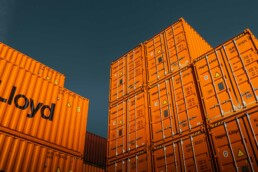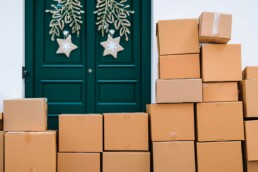Streamlining Supply Chain: The Role of 3PL
3PL Streamlining Supply Chain
The process of 3PL streamlining many supply chain aspects is important to understand for business owners. Efficient supply chain management is essential for success. Many companies turn to third-party logistics providers, commonly known as 3PL providers, to streamline their logistics operations. How 3PL’s are streamlining the supply chain has a direct impact on your ability to do business. In this article, we will delve into the world of 3PL providers and explore why they have become integral to modern supply chains.
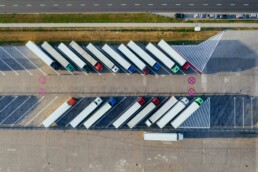
What Is A 3PL Provider?
A 3PL provider, or third-party logistics provider, is an external organization that takes on various aspects of a company’s logistics and transportation operations. This includes managing transportation, freight, warehousing, and other critical functions. Essentially, a 3PL company acts as an extension of your supply chain team, working to enhance transportation and supply chain efficiency.
Why Do Businesses Use 3PL Providers In Streamlining Supply Chains?
Businesses of all sizes benefit from partnering with 3PL providers. Whether it’s handling warehousing, transportation, or reverse logistics, these providers alleviate the burden on companies and enable them to focus on their core operations. In essence, companies engage 3PL providers to manage their logistics in a cost-effective and productive manner.
3PL vs. 4PL: Understanding the Difference
While 3PLs and 4PLs both play crucial roles in logistics management, they differ significantly in their scope of responsibility. A 4PL has a broader accountability, overseeing the entire supply chain. In contrast, a 3PL focuses on specific logistics functions, such as transportation and warehousing. Understanding this distinction is vital when choosing the right logistics partner for your business.
Services Provided by a 3PL Provider
When a company’s supply chain becomes too complex to handle in-house, outsourcing to a 3PL provider is a strategic move. These providers offer an array of services, including freight forwarding, transportation management, warehouse and inventory management, supply chain management, and technology integration. This comprehensive suite of services enables companies to optimize their logistics operations effectively.
Benefits of Using a 3PL Provider
Utilizing a 3PL provider in streamlining your supply chain comes with several advantages:
1. Time Savings: 3PLs reduce the manual workload, saving time on administrative tasks and paperwork.
2. Continuous Optimization: These providers constantly improve logistics processes, identifying gaps and inefficiencies.
3. Cost Savings: 3PLs leverage their network to negotiate lower transportation rates and reduce unnecessary costs.
4. Carrier Capacity: Access to a wide network of carriers ensures consistent support for freight volume.
5. Technology Visibility: 3PLs with TMS technology offer valuable insights into the supply chain.
6. Industry Insights: 3PLs bring industry knowledge and insights to the table, helping companies make informed decisions.
Choosing a Reliable 3PL Provider
Selecting the right 3PL provider is critical to the success of your logistics strategy. Consider the following factors:
1. Industry Expertise: Look for providers with years of experience and specialization in your industry.
2. Range of Services: Ensure they offer the services your company needs for effective logistics management.
3. Carrier Network: A broad network of reputable carriers is essential for smooth operations.
4. Customer Service: Evaluate their responsiveness and willingness to assist during the selection process.
5. Values: Ensure the provider’s core values align with your company’s culture and expectations.
Beginner’s Guide to Third-Party Logistics (3PL)
The world of e-commerce is always changing, therefore understanding the roll of Third-Party Logistics is integral to keeping up. In light of this our beginner’s guide to third-party logistics (3PL) will delve into the essential aspects, offering insights into fulfillment services, warehousing, and much more.
Read More…
3PL providers play a pivotal role in enhancing supply chain efficiency for businesses across various industries. By outsourcing logistics functions to these experts, companies can achieve time and cost savings, optimize operations, and gain valuable industry insights. When selecting a 3PL provider, consider factors such as industry expertise, services offered, carrier network, customer service, and shared values. Choosing the right 3PL partner can significantly contribute to the success of your logistics strategy.
Contact Falcon Fulfillment today for a free transportation cost analysis and discover how our 3PL services can elevate your logistics management.
Let’s Talk!
Reducing Product Returns: The True Cost of Product Returns
Reducing Product Returns: The True Cost of Inadequate Product Information
Reducing product returns will have a positive effect on your bottom line and your customer. The convenience for consumers often comes at a significant cost for retailers. Online shopping convenience has led to a surge in returns, impacting businesses’ bottom lines. It is important to understand the price retailers pay for flawed product information and why it’s crucial to address this issue.

The Real Cost of Returns
E-commerce has reshaped the shopping experience, offering consumers a seamless and hassle-free way to buy products. However, the ease of returning items has given rise to a substantial problem for retailers. The cost of processing, warehousing, return fraud, return shipping, nonsalable inventory, and return-related labor adds up to a significant revenue disruption, exerting immense financial pressure on businesses. Reducing product returns is a necessary part of e-commerce.
In 2022, consumers returned $212 billion worth of goods out of a total of $1.29 trillion in online retail sales, resulting in a 16.4% return rate. Some retailers, particularly in the fashion industry, experience return rates as high as 40%, an alarming statistic that places a substantial burden on their financial resources. Processing returns can be expensive, with costs averaging around $25 per return. For businesses processing thousands of returns, these costs can quickly escalate, creating a substantial financial burden that threatens profitability.
As retailers grapple with these escalating costs, it becomes evident that managing returns is more than just a logistical challenge; it’s a financial imperative. The impact of returns extends far beyond processing fees, affecting a retailer’s bottom line and forcing a reassessment of policies. The growing expenses associated with returns necessitate a strategic approach to mitigate their impact on the business’s profitability.
Balancing Customer Expectations
Returns occur for various reasons, some beyond a retailer’s control. Customers may buy products intending to try them or receive unwanted gifts, leading to returns. Many causes for return are outside a retailer’s control, emphasizing the need to balance customer expectations and return policies effectively.
In the e-commerce landscape, retailers must accommodate customer expectations while minimizing return rates stemming from controllable issues. The challenge lies in identifying and addressing preventable return causes.
Retailers prioritize customer convenience, offering flexible return policies within set time frames to enhance the shopping experience. However, maintaining this balance is essential, reducing returns due to retailer errors.
Retailer errors contribute significantly to returns, from wrong products to inaccurate descriptions and website-related issues. Investing in solutions like Product Information Management (PIM) and Product Experience Management (PXM) systems plays a crucial role. These systems ensure accurate product information, reducing return risk.
By providing accurate, detailed information, retailers foster trust and loyalty while mitigating financial and logistical challenges posed by returns. Achieving this balance is crucial in the competitive e-commerce landscape.
Building Trust with Accurate Product Information
In the competitive e-commerce landscape, trust is a retailer’s most valuable asset. Reducing return rates, especially those rooted in factors under their control, is both a financial imperative and a strategic priority. Savvy retailers make deliberate investments in advanced solutions like Product Information Management (PIM) and Product Experience Management (PXM) systems, recognizing their pivotal role in enhancing the shopping experience.
These systems serve a multifaceted purpose by ensuring product information remains consistently accurate and up-to-date, all while preserving persuasive sales copy. Retailers, regardless of the size of their product assortment, find in these systems a robust foundation upon which they can construct more robust and enduring relationships with their customers. These systems serve as beacons of reliability and unwavering accuracy in an arena where trust is paramount.
Leveraging 3PL Partnerships for Reducing Product Returns
One highly effective strategy for mitigating return-related issues is partnering with a reputable 3PL (Third-Party Logistics) provider. 3PL providers specialize in various aspects of the supply chain, including warehousing, inventory management, and order fulfillment. By entrusting these critical components of the business to experts, retailers can significantly enhance their operational efficiency and accuracy, reducing the risk of returns. In addition, 3PL’s can assist in the return process helping you stay focused on your business and not focused on returns.
By partnering with a trusted 3PL provider, retailers can tap into a wealth of expertise and resources, effectively reducing return-related issues. This strategic collaboration not only enhances operational efficiency but also fosters a more satisfactory shopping experience for customers. In the competitive landscape of e-commerce, reducing return rates and enhancing customer trust are strategic imperatives, and 3PL partnerships are a valuable tool in achieving these objectives.
Beginner’s Guide to Third-Party Logistics (3PL)
The world of e-commerce is always changing, understanding the roll of Third-Party Logistics is integral to keeping up. This beginner’s guide to third-party logistics (3PL) will delve into the essential aspects, offering insights into fulfillment services, warehousing, and much more.
Read More…
Managing returns is a challenge, but it also presents an opportunity for innovation. Investing in product information systems is essential for retailers looking to minimize costly returns and establish lasting trust with consumers.
The true price that retailers pay for flawed product information is not just financial but also affects their reputation and customer loyalty. Accurate and detailed product information is the key to reducing return rates and fostering trust with consumers in the competitive world of e-commerce.
When accurate shipping matters, Falcon Fulfillment leads with a 99.9% accuracy rate.
Let’s Talk!
Breaking Down Domestic Shipping Costs: Avoid Hidden Fees & Understand The Real Costs
Breaking Down Domestic Shipping Costs and Avoiding Hidden Fees
Understanding The Real Costs
Since 98% of domestic shipments are delivered to the lower 48 states, we will focus on these shipment groups. We will break down how to determine the actual shipping costs for shipments and how to avoid unnecessary costs.
Domestic shipping costs often seem simple at first glance, but they can quickly become complicated once hidden fees and unexpected surcharges are factored in. Many businesses and individual shippers may initially focus on the base “net” rates advertised by carriers, or offered to you by your fulfillment company, yet that’s often just part of the story. Knowing what actually makes up domestic shipping costs—and how to avoid common extra charges—can help shippers make better, more cost-effective choices.
In this guide, we’ll take a closer look at the components that make up domestic shipping costs, the fees that may be hiding in the fine print, and the practical steps you can take to minimize those costs. By the end, you’ll have a clearer understanding of the domestic shipping landscape, along with a handy spreadsheet to help you compare different shipping methods and make the best decision for your needs.
Understanding Domestic Shipping Costs: The Core Components

Understanding Domestic Shipping Costs: The Core Components
Domestic shipping costs are typically composed of several main charges that vary based on the shipping carrier, the type of service, and the package itself. Although these charges differ, most domestic shipments include similar key elements. Let’s look at each of these in detail:
- Base Rate – This is the starting price of any shipment and is usually determined by the weight, dimensions, and distance the package will travel. For example, a lightweight package sent across a short distance will generally incur a lower base rate than a heavy or oversized package traveling across the country.
- Fuel Surcharges – Fuel surcharges are added by most shipping companies to cover fluctuating fuel prices. They’re not always included in the initial quote, but they can be significant, especially for larger shipments.
- Handling Fees – Packages that require special handling (for example, those with fragile or hazardous contents) are often subject to additional fees. Handling fees cover the extra care, packaging, or labor needed to ensure safe delivery.
- Delivery Area Surcharges – Shipments to rural or remote areas may incur delivery area surcharges. Carriers consider these locations less accessible and therefore charge extra to deliver to them. This is a common fee, and it can be surprising if you aren’t aware of it.
Understanding these core components of domestic shipping costs helps in building a foundation for what to expect on your invoice. However, hidden fees often emerge once the shipment is in progress. Knowing what to look for can help you avoid these additional costs.
Hidden Fees to Watch For in Domestic Shipping
Hidden fees are extra charges that aren’t always included in an initial quote. They often show up in the final invoice, leaving shippers with unexpected costs. Here are some of the most common hidden fees to be aware of when shipping domestically:
- Residential Delivery Fees – Many carriers charge an extra fee when delivering to residential addresses instead of commercial ones. This is due to the typically less streamlined nature of residential delivery routes, which can result in higher operational costs for the carrier.
- Dimensional Weight Pricing – Dimensional (DIM) weight pricing applies when carriers charge for package size rather than actual weight. This can raise the cost of domestic shipping significantly, particularly for items that are large but lightweight. If DIM weight pricing is in play, it’s important to optimize your package size to avoid extra costs.
- Address Correction Fees – Address correction fees occur if there’s an error in the shipping address, requiring the carrier to make a correction mid-delivery. Carriers may charge a flat fee or a per-package fee for these adjustments, which can be costly for businesses shipping in bulk. Verifying addresses before dispatch can help you avoid this charge.
- Saturday Delivery Fees – If you need to deliver on a Saturday, be prepared for an extra charge. Most standard shipping services exclude weekend delivery, so this fee can be a surprise for businesses trying to meet tight timelines.
Practical Tips for Reducing Domestic Shipping Costs
Now that we’ve identified common hidden fees, let’s look at ways to avoid them and keep your domestic shipping costs down. Reducing these fees isn’t just about understanding the different charges; it’s also about taking specific actions that help streamline your shipping processes. Here are some tips:
- Review Shipping Quotes Carefully – Reviewing each quote you receive is one of the easiest ways to avoid hidden fees. Take the time to read through every line item, checking for any unfamiliar fees. Compare these charges against the carrier’s rate guide to see if they’re reasonable, and if something looks unusual, reach out to your carrier for clarification.
- Optimize Package Size and Weight – Dimensional weight pricing can add up quickly, especially for larger items. Where possible, adjust packaging to reduce overall size. Using smaller, durable boxes that don’t exceed the carrier’s size limits can prevent inflated DIM weight charges.
- Negotiate with Your Carrier – Many carriers offer special rates or discounts for customers who ship frequently. If you find that hidden fees are common in your shipments, reach out to your carrier’s sales representative. They may be able to help you find discounted services or waive certain fees based on your shipping volume.
- Validate Addresses – Address correction fees are avoidable by simply verifying addresses beforehand. Whether you use address validation software or manually check each address, this extra step can help avoid costly corrections.
By following these steps, you can keep your domestic shipping costs more predictable and minimize the impact of hidden fees on your shipping budget.
Domestic Shipping Costs Comparison Tool
Understanding domestic shipping costs fully requires a way to compare different options side-by-side. To assist with this, we’ve included a detailed comparison spreadsheet that breaks down base rates, fuel surcharges, and other potential fees across major domestic shipping methods. Using this tool, you can see where costs add up and make informed decisions based on the specific needs of each shipment.
| Carrier | Service Level | Fuel | Residential | DAS (Delivery Area Surcharge) | EXDAS (Extended Delivery Area Surcharge) | Peak |
| How is it calculated: | % | Flat rate | Flat rate | Flat rate | Varies | |
| How often: | Every Shipment | Every Shipment (If checked below) | If Applicable | If Applicable | Varies | |
| FedEx | DOMESTIC | DAS MAP | ||||
| Ground Economy | X | X | X | X | ||
| Ground Commercial | X | X | X | X | ||
| Ground Home Delivery | X | X | X | X | X | |
| 2-Day Air | X | X | X | X | ||
| 1-Day Overnight | X | X | X | X | ||
| UPS | DOMESTIC | |||||
| SurePost | X | X | X | X | ||
| Ground Commercial | X | X | X | X | ||
| Ground Home Delivery | X | X | X | X | X | |
| 2-Day Air | X | X | X | X | ||
| 1-Day Overnight | X | X | X | X | ||
| UPS Mail Innovations | DOMESTIC | |||||
| Parcel Expedited | X | X | ||||
| DHL eCommerce | DOMESTIC | |||||
| Parcel Ground | X | X | ||||
| Parcel Expedited | X | X | ||||
| Expedited MAX | X | X | ||||
| USPS | DOMESTIC | |||||
| Ground Advantage | X | X | ||||
| First Class | X | X | ||||
| Priority Mail | X | X |
Beginner’s Guide to Third-Party Logistics (3PL)
The world of e-commerce is always changing, therefore understanding the roll of Third-Party Logistics is integral to keeping up. In light of this our beginner’s guide to third-party logistics (3PL) will delve into the essential aspects, offering insights into fulfillment services, warehousing, and much more.
Read More…
Looking for Personalized Help?
If you’re still finding domestic shipping costs difficult to navigate or would like personalized guidance on reducing your expenses, Falcon Fulfillment is here to help. Our team can work with you to create a shipping strategy that avoids hidden fees, reduces overall costs, and ensures smooth delivery.
Make the right choice and optimize your fulfillment strategy.
Let’s Talk!
Order Fulfillment Company Models, Choosing the Right One
Selecting the Perfect Order Fulfillment Company Model for Your Business Success
When it comes to order fulfillment, making the right choice is paramount for your business. With an array of options available, it’s essential to navigate the complexities and select the ideal fulfillment model. This comprehensive guide explores the pros and cons of various order fulfillment company models to help you make an informed decision.
Order Fulfillment Company Models

Large Global Logistics Companies
Large global logistics giants offer extensive global networks, making them perfect for international fulfillment. However, they may lack personalized service and e-commerce specialization.
Pros:
Extensive Network: Their reach extends across multiple countries, catering to a global market.
One-stop Solution: They provide a comprehensive range of services, from warehousing to customs clearance.
Technology Integration: Large global logistics firms invest in advanced technology for efficient tracking and management.
Cons:
Impersonal Service: While excelling in scale, they may lack a high level of personalized service.
Lack of Customization: These companies tend to favor standardized processes, making customization challenging.
Complex Fee Structures: Understanding their pricing and fees can be difficult, affecting budgeting.
Large National Logistics Companies
Large national logistics companies with nationwide locations enable scalability and quick domestic shipping. However, you might receive less personalized attention and face cost challenges.
Pros:
Multiple Locations: They boast a network of facilities across the country for easy scalability and domestic shipping.
Technology: Many have robust technology systems in place, enhancing tracking and management.
Cons:
No Fulfillment Focus: Some larger providers primarily focused on trucking or warehousing, which may not align with your specific needs.
Less Personal Attention: The level of customization and attention can vary depending on your business size.
National Providers with a Fulfillment Specialty
Providers in this category offer a balanced combination of scale and personalized service with customized solutions. However, they may lack the global capabilities of the largest logistics companies.
Pros:
Focused Expertise: They specialize in pick and pack services, crucial for direct-to-consumer brands.
Balanced Service: Mid-sized firms strike a balance between scalability and personalized service.
Customized Solutions: Tailored solutions are available to meet specific B2C fulfillment requirements.
Cons:
Limited Global Scale: Mid-sized companies may lack international infrastructure, limiting global reach.
Variable Technology Capabilities: Their technology systems may not be as advanced as larger competitors.
Small, Local, or Regional Logistics Companies
Local and regional logistics fulfillment providers excel at personalized service and cost-effectiveness. However, they may struggle to meet growing fulfillment requirements.
Pros:
Highly Personalized Service: They offer exceptional customer service with personalized attention.
Cost-Effectiveness: Competitive pricing for local or regional fulfillment makes them suitable for smaller businesses.
Cons:
Limited Ability to Scale: These companies may not support high order volumes and large-scale operations.
Limited Automation: Lack of automation can result in higher costs.
Fulfillment By Amazon (FBA)
Fulfillment By Amazon provides fast last-mile delivery and convenience, particularly for Amazon sellers. However, it comes with high fees, brand visibility limitations, and restrictions on control.
Pros:
Fast Delivery: FBA offers fast and reliable delivery, especially for Amazon Prime members.
Ease of Use: It’s a ready-made solution for Amazon sellers, streamlining the fulfillment process.
Cons:
High Fees: Amazon’s fees can significantly impact profit margins.
Limited Brand Visibility: Custom packaging is not an option, and products ship in Amazon-branded packaging.
Restrictions and Control: Amazon has strict guidelines and retains significant control over inventory and customer interaction.
Beginner’s Guide to Third-Party Logistics (3PL)
The world of e-commerce is always changing, therefore understanding the roll of Third-Party Logistics is integral to keeping up. In light of this our beginner’s guide to third-party logistics (3PL) will delve into the essential aspects, offering insights into fulfillment services, warehousing, and much more.
Read More…
The Choice Between Order Fulfillment Company Models
In the intricate world of order fulfillment, selecting the ideal order fulfillment company model is crucial. From global logistics giants to local champions and Amazon’s convenience, each option presents unique advantages and limitations. Careful evaluation is key to ensuring your business’s supply chain management aligns with your unique requirements.
Explore Falcon Fulfillment’s tailored fulfillment solutions to find the perfect fit for your business needs. Contact us today to learn more about our model.
Make the right choice and optimize your supply chain management today.
Let’s Talk!
The Key Elements of Successful E-commerce Fulfillment Process
The Key Elements of Successful E-commerce Fulfillment: Avoiding Costly Mistakes
An efficient and effective fulfillment process is the key to ensuring customer satisfaction, business growth, and staying ahead of the competition. Falcon Fulfillment, your trusted partner in logistics and fulfillment services, is here to guide you through the crucial elements of a successful e-commerce fulfillment process and the mistakes that could jeopardize your success.
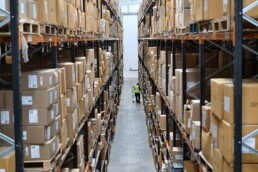
E-commerce Fulfillment Process Essentials
Third-Party Logistics (3PL): The foundation of a successful e-commerce fulfillment process often starts with partnering with a reliable 3PL provider. These experts specialize in handling warehousing, distribution, and logistics, allowing you to focus on your core business activities.
Inventory Management: Efficiently managing your inventory is vital. Real-time tracking, demand forecasting, and accurate stock levels are essential to avoid overstocking or running out of popular items.
Shipping and Delivery: Smooth and timely shipping is critical. Consider options like same-day and next-day delivery, last-mile delivery solutions, and efficient cross-docking to streamline your delivery process.
Supply Chain Management: A well-optimized supply chain is crucial for a seamless fulfillment process. It encompasses various elements like freight forwarding, bulk shipping, and value-added services to enhance efficiency.
Order Tracking and Management: Provide your customers with the ability to track their orders. Implement a user-friendly order tracking system to keep your customers informed.
Safety and Security Measures in Warehousing: Ensure that your fulfillment center follows strict safety and security measures to protect your products and maintain their quality.
3PL Technology Solutions: Leverage technology to streamline your operations. A Transportation Management System (TMS) can help manage carriers, while cloud-based Warehouse Management Systems (WMS) can optimize warehouse operations.
Common Mistakes to Avoid
Inadequate Inventory Management: Failing to maintain accurate inventory records can lead to overstocking, understocking, and unhappy customers. Implement inventory tracking software to avoid this pitfall.
Poor Quality Control: Ignoring quality control can result in shipping incorrect or damaged products. Implement stringent quality checks to ensure that every order is accurate and of the highest quality.
Inefficient Shipping: Slow or unreliable shipping can turn away customers. Focus on optimizing your shipping and delivery methods to provide timely service.
Lack of Scalability: As your e-commerce business grows, your fulfillment process should be able to scale accordingly. Ensure that your fulfillment partner can handle your increasing order volume.
Ignoring Returns: Return Merchandise Authorization (RMA) processing is often overlooked. A streamlined returns process is essential for maintaining customer trust and satisfaction.
Inadequate Reporting: Not keeping a close eye on order fulfillment metrics and reporting can hinder your ability to optimize your process. Utilize data to identify areas for improvement.
Ineffective E-commerce Integration: Seamless integration with your e-commerce platform is crucial. Consider multi-channel fulfillment and kitting and assembly services for a well-rounded approach.
Neglecting Cost Analysis: Fulfillment costs can eat into your profits if not monitored carefully. Conduct regular fulfillment cost analysis and negotiation with freight rates to keep expenses in check.
Failing to Plan for Growth: E-commerce businesses should have a demand planning strategy in place to anticipate growth and potential surges in orders.
Overlooking Shipment Consolidation: Efficient shipment consolidation reduces costs and environmental impact. Utilize this practice whenever possible.
Beginner’s Guide to Third-Party Logistics (3PL)
The world of e-commerce is always changing, therefore understanding the roll of Third-Party Logistics is integral to keeping up. In light of this our beginner’s guide to third-party logistics (3PL) will delve into the essential aspects, offering insights into fulfillment services, warehousing, and much more.
Read More…
In summary, a successful e-commerce fulfillment process is built on a strong foundation of logistics, technology, and efficient management. Avoiding common mistakes and optimizing your process is essential for achieving long-term success in the e-commerce industry. Falcon Fulfillment is here to help you navigate this complex landscape and ensure your fulfillment process runs like a well-oiled machine.
Remember, your e-commerce venture’s success depends on the strength of your fulfillment process. Don’t let these common pitfalls hinder your growth. Partner with Falcon Fulfillment and soar above the competition with our comprehensive e-commerce fulfillment solutions. Your success is our commitment.
For more insights and expert advice on e-commerce fulfillment talk to someone at Falcon Fulfillment.
Let’s Talk!
Navigating Transportation in E-commerce: Strategies for Success
Successfully Navigating Transportation in E-commerce
In today’s ever changing e-commerce landscape, transportation has become more complex than ever before. Gone are the days when selecting a carrier solely based on the best rates guaranteed smooth sailing for your business. The growth of e-commerce, especially in recent years, has led to a capacity crunch in the industry, creating a host of new challenges for brands and retailers alike. Navigating transportation in e-commerce can be confusing, especially with it’s unstable nature. We’ll delve into the intricacies of e-commerce transportation and discuss why building a diverse carrier network and partnering with the right 3PL (Third-Party Logistics) provider are crucial steps in ensuring your business’s success and sustainability.

The E-commerce Boom and Capacity Crunch
The e-commerce sector has experienced explosive growth, with a combined annual growth rate of nearly 18% in the United States alone over the last decade. This growth has led to a significant increase in the volume of parcels entering the supply chain, causing what’s often referred to as ‘shipageddon.’ This term was coined during the peak of 2020 when millions of e-commerce orders failed to meet Christmas delivery deadlines due to capacity issues.
To adapt to this changing landscape, national carriers have shifted their approach, prioritizing profitability and higher margins over quantity. This shift has resulted in brands facing surcharges and volume caps, highlighting the need to diversify their carrier network and develop a strategic approach to transportation.
The New Rules of Transportation
In this complex environment, relying on a single carrier is no longer viable. Brands must now establish relationships with multiple carriers to ensure timely order fulfillment. This necessitates a well-thought-out and strategic approach to transportation, which can be challenging for many mid-size brands that lack the in-house resources to keep up.
Even larger enterprises are grappling with the rapid changes in the industry, making it essential to have individuals well-versed in transportation trends and challenges. Knowledge is power in this scenario, allowing businesses to anticipate and navigate potential risks that may threaten their operations.
Building a Diverse Carrier Network
The recent UPS strikes serve as a stark reminder of the risks associated with single-sourcing within transportation. Alternative carriers have become more specialized, offering unique advantages for brands that can leverage their specializations effectively. However, selecting the right carriers has become a daunting task, as rate cards now hide various hidden costs, including fuel surcharges, address corrections, and extended area zip codes.
The Role of Technology
While technology, such as Transportation Management Systems (TMS), can aid in managing transportation operations, it is not a one-size-fits-all solution. The suitability of a transportation solution depends on various factors that must be considered to achieve the desired benefits. Technology can support and inform your strategy, but it cannot replace the need for a well-defined and expertly executed transportation strategy.
Sustainability in Transportation
Transportation strategies also have a direct impact on sustainability. By optimizing transportation networks and reducing last-mile delivery through multi-node fulfillment, brands can simultaneously increase profitability and reduce carbon emissions. Leveraging capacity on passenger planes for cargo transportation is another sustainable approach that requires carrier diversity and optimization.
The Insourcing vs. Outsourcing Debate
There is a valid concern about relinquishing control over transportation when outsourcing to a third-party logistics provider (3PL). Brands may worry about a lack of knowledge and vulnerability. However, the key to success lies in selecting the right 3PL partner. Trust is essential in this partnership, and the right 3PL should proactively address transportation challenges and collaborate with brands to ensure smooth operations.
Beginner’s Guide to Third-Party Logistics (3PL)
The world of e-commerce is always changing, therefore understanding the roll of Third-Party Logistics is integral to keeping up. In light of this our beginner’s guide to third-party logistics (3PL) will delve into the essential aspects, offering insights into fulfillment services, warehousing, and much more.
Read More…
Navigating transportation in e-commerce demands a strategic and diversified approach. Building a diverse carrier network and partnering with a trusted 3PL provider are essential steps in navigating this complexity. By embracing these strategies, brands can not only ensure their success in a rapidly evolving industry but also contribute to sustainability efforts.
In a landscape where change is constant, knowledge and the right partnerships are your greatest assets.
Let’s Talk!
Consumer Spending Trends Impact on E-Commerce
Consumer Spending Trends In E-commerce
Consumer spending trends on e-commerce have been on a wild ride the last few years. A recent analysis by the National Retail Federation (NRF) highlights an ongoing decrease in consumer spending. It is essential for businesses involved with third-party logistics (3PL) and fulfillment services to understand the implications. In this article, we’ll delve into how consumer spending trends impact the supply chain and what this means for the world of warehousing and distribution.
Economic Shifts
The NRF’s Chief Economist, Jack Kleinhenz, recently pointed out that while U.S. consumers are making purchases at a higher rate compared to a year ago. The rate of growth in spending is slowing down. This change comes in the wake of higher interest rates aimed at reducing inflation. Kleinhenz noted, “The economy was clearly more resilient in the first half of this year than many expected, and the consumer environment has been positive as inflation has slowed. Nonetheless, there are ongoing economic challenges and questions, and the pace of consumer spending growth is becoming incrementally slower.”
These economic shifts have significant ramifications for businesses engaged in order fulfillment solutions, particularly those involved in e-commerce fulfillment. Consumers are adapting to financial pressures by adjusting their buying habits, shifting from physical goods to services. While job and wage gains have countered inflation, the stockpile of savings accumulated during the pandemic is dwindling, resulting in reduced spending.
The Data Points
NRF provides various data points that shed light on the current economic outlook:
- Second-quarter GDP increased to 2.4%, adjusted for inflation.
- Annual spending growth decreased from 4.2% in the first quarter to 1.6% in the second quarter.
- Second-quarter retail sales, excluding automobile dealers, gas stations, and restaurants, grew by 3.1% on an unadjusted basis annually.
- The Personal Consumption Index showed a 3.7% annual increase in the second quarter, though down from the first quarter’s 4.9% reading.
Economic Landscape and Mixed Signals
These factors indicate a complex economic landscape with mixed signals. For businesses in the shipping and delivery sector, these trends translate into fluctuations in demand and potentially lower freight volumes. The key question remains: How long will this period of reduced consumer demand persist?
While the answer to that question remains uncertain, there’s a sentiment that as we approach 2025, we could see a return to a more normalized economic landscape, reminiscent of the pre-pandemic era. A gradual shift towards steady consumer activity and increased demand for goods transported via various channels, including multi-channel fulfillment, may be on the horizon.
Beginner’s Guide to Third-Party Logistics (3PL)
The world of e-commerce is always changing, therefore understanding the roll of Third-Party Logistics is integral to keeping up. In light of this our beginner’s guide to third-party logistics (3PL) will delve into the essential aspects, offering insights into fulfillment services, warehousing, and much more.
Read More…
Understanding the impact of these insights on consumer spending trends is crucial for businesses in the retail sector and the fulfillment center industry. As the economic landscape evolves, staying informed about these shifts and adapting supply chain strategies accordingly will be vital for success in the competitive e-commerce world and fulfillment services of the future.
Looking for a fulfillment solution that will help you stay on top and scale?
Let’s Talk!
E-commerce Strategy Plan To Attract and Retain Online Shoppers
E-commerce Strategy Plan to Attract, Convert, and Retain Shoppers
In e-commerce, crafting a well-defined strategy is paramount to success. The digital marketplace is teeming with options for online shoppers, making it crucial for businesses to not only attract visitors but also convert them into loyal customers. In this e-commerce strategy plan, we’ll explore the power of third-party logistics (3PL) and fulfillment services in optimizing your operations. Optimizing your e-commerce plan is central to delivering exceptional customer experiences. Join us to discover how to not just survive, but thrive, in the competitive world of online retail.
Navigating the Complex Ecommerce Landscape
Before we delve into the specifics of optimizing your e-commerce strategy, it is important to understand the intricacies of the e-commerce landscape. E-commerce is not merely about establishing an online store and crossing your fingers. It entails a complicated web of processes, encompassing warehousing and distribution, order fulfillment solutions, inventory management, and the critical realm of shipping and delivery.

The Crucial Role of 3PL in Ecommerce
Third-party logistics (3PL) providers serve as the unsung heroes of the e-commerce realm. These specialized entities offer a wide array of services, including supply chain management, last-mile delivery, cross-docking, and much more. Collaborating with a reputable 3PL provider can revolutionize your operations, enhancing efficiency and customer satisfaction.
Fulfillment Services: The Backbone of Ecommerce
Efficient order fulfillment stands as a cornerstone of any flourishing e-commerce venture. E-commerce fulfillment services encompass a broad spectrum of activities, ranging from freight forwarding and reverse logistics to bulk shipping and vendor-managed inventory (VMI). These services ensure that your products reach customers swiftly and in pristine condition.
Elevating the Customer Experience
In the fiercely competitive e-commerce arena, offering an unparalleled customer experience can set you apart from the pack. This involves providing enticing options such as same-day and next-day delivery, robust order tracking and management, and meticulous attention to order accuracy through comprehensive quality control measures.
The Art of Supply Chain Optimization
Optimizing your supply chain lies at the heart of a triumphant e-commerce strategy. Key components of this optimization journey include strategies like freight consolidation, value-added services (VAS), customs brokerage, and the agility of dropshipping solutions. These tactics are instrumental in reducing costs, elevating efficiency, and exceeding customer expectations.
Embracing the Power of Technology
In today’s digital age, technology reigns supreme. E-commerce enterprises can harness technology solutions like a transportation management system (TMS), state-of-the-art inventory tracking software, and the seamless integration of cloud-based warehouse management systems (WMS). These tools empower businesses with real-time visibility into operations, facilitating informed decision-making.
Measuring Triumph with Metrics
To refine and perpetually enhance your e-commerce strategy, meticulous measurement is essential. Keep a vigilant eye on critical metrics such as inventory forecasting, order fulfillment metrics and reporting, scalability of fulfillment solutions, and the finesse of return merchandise authorization (RMA) processing. These data-driven insights pave the path to strategy refinement.
Beginner’s Guide to Third-Party Logistics (3PL)
The world of e-commerce is always changing, therefore understanding the roll of Third-Party Logistics is integral to keeping up. In light of this our beginner’s guide to third-party logistics (3PL) will delve into the essential aspects, offering insights into fulfillment services, warehousing, and much more.
Read More…
In the fiercely competitive world of e-commerce, a finely-tuned strategy that incorporates third-party logistics (3PL) and fulfillment services is the key to not only servicing, satisfying, and retaining online shoppers but also thriving in the digital marketplace. As you embark on this journey, remember that success in e-commerce is a perpetual journey. The ability to adapt to evolving customer demands and market trends is your ultimate asset. By maintaining agility and refining your strategy, you can sustain growth and profitability in the dynamic world of online retail.
Looking to partner with a company that takes your customer as seriously as you do?
Let’s Talk!
Amazon Shipping Parcel Delivery Could Shake Up the Industry
How Amazon Shipping Could Shake Up the Parcel Delivery Industry
The parcel delivery industry has long been dominated by giants like UPS and FedEx. However, with the relaunch of Amazon Shipping parcel delivery, a new force is emerging, poised to disrupt traditional logistics models. Amazon’s move into this space is significant not just for e-commerce fulfillment but also for third-party logistics (3PL) providers, small businesses, and even consumers. In this blog, we’ll explore how Amazon Shipping parcel delivery could impact the industry, offering opportunities and challenges alike for all parties involved.
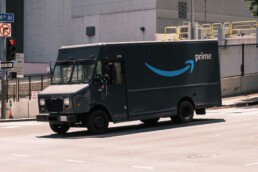
A New Era for Parcel Delivery
Amazon has developed a massive logistics and fulfillment network, giving it the infrastructure to manage millions of shipments every day. However, Amazon Shipping represents a shift in strategy. It offers small- and medium-sized businesses the ability to use Amazon’s extensive delivery network for packages outside of Amazon orders, shaking up traditional delivery services.
Amazon’s decision to enter the parcel delivery market comes at a time when e-commerce fulfillment has grown dramatically. Businesses increasingly need efficient shipping and delivery options to meet rising customer expectations, especially for same-day and next-day delivery. By leveraging their logistics expertise, Amazon Shipping is positioned to challenge the existing order of warehousing and distribution models.
Key Differentiators of Amazon Shipping
Amazon Shipping is set apart from traditional carriers by offering simplified rates, faster delivery times, and fewer hidden fees. Small- and medium-sized businesses that don’t have the resources to negotiate complicated contracts with carriers like FedEx and UPS could find Amazon’s streamlined service appealing. These businesses may also benefit from reduced shipping surcharges and access to Amazon’s extensive order tracking and management tools, which will help improve order fulfillment solutions.
Moreover, Amazon Shipping also integrates well with various e-commerce platforms, providing sellers a chance to optimize their delivery operations, ultimately improving supply chain optimization and inventory management. By tapping into Amazon’s vast network, even businesses without the capital to invest in their own fulfillment center can still offer competitive delivery services.
Impact on the Supply Chain
The introduction of Amazon Shipping parcel delivery is a game-changer for the parcel delivery sector, and it raises questions about how traditional shipping companies will respond. For example, third-party logistics providers and 3PL technology solutions could benefit from Amazon’s entry into the market by partnering with them for better inventory tracking and faster shipping times.
However, there’s potential disruption as well. Supply chain management systems will need to adjust, especially for businesses heavily reliant on traditional carriers. As Amazon expands its last-mile delivery services, competing companies will need to improve their value-added services (VAS), such as reverse logistics, bulk shipping, and kitting and assembly, to maintain their edge.
Transitioning from Fulfillment Giant to Parcel Delivery Leader
While Amazon has long been a leader in fulfillment services, offering multi-channel fulfillment and scalable fulfillment solutions to sellers, its foray into parcel delivery is relatively new. Nonetheless, its vast network of warehousing and distribution centers, combined with an advanced transportation management system (TMS), provides a solid foundation for disrupting the delivery industry.
Amazon Shipping could become a critical player for businesses aiming to reduce costs while increasing efficiency. For example, its focus on carrier selection and management and customs brokerage for international shipping could make it a viable alternative to traditional shipping companies for cross-border trade. Additionally, with Amazon’s existing expertise in freight consolidation, the company could further optimize its shipping network to reduce transit times and costs, making them a formidable competitor in parcel delivery.
The Role of Technology in Amazon Shipping
One of the most critical factors in Amazon Shipping’s potential success is its integration of technology. The service offers robust inventory management and order accuracy tools, which help streamline operations for sellers and improve the customer experience. These tools, paired with Amazon’s cloud-based warehouse management system (WMS), ensure real-time order tracking and faster shipping times.
Amazon Shipping’s use of data and automation in their fulfillment center operations ensures higher order accuracy and quality control, giving them a competitive advantage. These systems allow for inventory forecasting and demand planning, which can be crucial during peak seasons, ensuring businesses can meet consumer demand without delays.
Challenges Facing Amazon Shipping
While Amazon Shipping parcel delivery holds immense potential, there are challenges that could hinder its growth. One of the key concerns is Amazon’s dependence on other carriers, such as UPS and the U.S. Postal Service, for certain deliveries, particularly in more remote areas. This reliance could create bottlenecks, especially during high-demand periods like holiday seasons or during Amazon Prime events.
Another challenge lies in building trust with businesses. Larger enterprises may be reluctant to shift away from existing carrier relationships with volume discounts. Also, there’s uncertainty surrounding how Amazon will prioritize shipments, especially if conflicts arise between deliveries for Amazon.com and Amazon Shipping customers.
Long-Term Implications for the Industry
The future of Amazon Shipping parcel delivery is promising, but it will take time for the service to become a major player in the parcel delivery space. In the short term, it’s likely that Amazon will target smaller, e-commerce fulfillment providers who will benefit from their straightforward pricing and cross-docking solutions. Over time, as Amazon builds trust and expands its capabilities, it could pose a significant threat to existing delivery giants.
The long-term implications of Amazon Shipping for the parcel delivery industry are clear: traditional carriers will need to innovate and offer better third-party logistics solutions and enhanced services such as freight forwarding, freight rate negotiation, and improved freight audit and payment services. Businesses and consumers alike could benefit from more competitive shipping rates, faster delivery options, and improved customer experiences.
Beginner’s Guide to Third-Party Logistics (3PL)
The world of e-commerce is always changing, therefore understanding the roll of Third-Party Logistics is integral to keeping up. In light of this our beginner’s guide to third-party logistics (3PL) will delve into the essential aspects, offering insights into fulfillment services, warehousing, and much more.
Read More…
Amazon Shipping’s reentry into the parcel delivery market represents a pivotal moment for the industry. As the service continues to evolve, it will likely shape the future of shipping and delivery for businesses of all sizes. By offering more accessible, cost-effective, and reliable options, Amazon Shipping could significantly impact traditional delivery services and reshape how companies approach order fulfillment.
In the coming years, we’ll likely see a more competitive landscape, driven by Amazon’s presence in last-mile delivery and same-day and next-day delivery services. For businesses, staying ahead of these changes and optimizing their supply chain management will be crucial for success. Looking for a fulfillment solution to help you navigate these changes?
Let’s Talk!
Choosing the Best Holiday Shipping Options for E-commerce
Holiday Shipping: Which Option is Best for E-commerce?
Holiday shipping options are a critical consideration as 4th quarter approaches, and e-commerce businesses gear up for the peak season. 38% of consumers are most concerned about delivery delays during this time. To ensure a successful 4th quarter, it’s essential to choose the right holiday shipping option that suits your business needs.
In this guide, we’ll explore different holiday shipping options, from the popular free shipping to flat rate and exact cost shipping, and even expedited and BOPIS (buy online, pick up in-store) choices.

Free Shipping
While free shipping is an enticing prospect for customers, it’s not a walk in the park for e-commerce businesses. Here’s the deal: someone has to foot the bill for shipping, and it’s not your carrier doing it for free. It’s the customers who ultimately pay for free shipping. E-commerce businesses typically achieve this by encouraging customers to spend more to qualify for free shipping, essentially building the shipping cost into the product prices or order totals. As shocking as it may sound, free shipping isn’t really “free.”
Pros:
- Reduces shopping cart abandonment.
- Attracts and retains customers.
- Increases sales.
Cons:
- May lead to higher product prices.
- If shipping rates increase, costs rise for your business.
- Budget shipping options may result in subpar delivery experiences.
Flat Rate Shipping
If you’re caught between raising product prices and absorbing shipping costs, flat rate shipping offers an alternative. With this option, you set a fixed shipping fee that covers most of your shipping expenses, providing customers with a predictable cost. However, if a customer purchases heavy items, your business may need to absorb additional costs.
Pros:
- Predictable shipping costs.
- Avoids surcharges.
- Includes shipping insurance.
Cons:
- Can’t use branded packaging.
- May incur extra expenses for heavy items.
- Local customers might find it costly.
Is Flat Rate Shipping Right for You? This option suits e-commerce businesses with small yet heavy inventory, like books and monthly subscriptions.
Exact Cost Shipping
Exact cost shipping, also known as real-time carrier shipping, automatically calculates shipping charges at checkout based on factors like weight, dimensions, and destination. It’s a straightforward but transparent option that may lead to higher cart abandonment rates.
Pros:
- Accurately calculates shipping costs.
- Charges customers a precise amount.
- Boosts international sales.
Cons:
- May increase cart abandonment.
- Can’t be used for promotional purposes.
Is Exact Cost Shipping Right for You? This is recommended for e-commerce brands unable to include shipping costs in product prices. It prevents losses on both delivery and merchandise.
Same-day, 2-day & Expedited Shipping
During the holidays, customers’ patience for waiting diminishes. Fast shipping options like same-day, 2-day, and expedited shipping become crucial for timely delivery. While these options are more expensive, they satisfy customers’ impatience and can enhance loyalty.
Pros:
- Quick delivery.
- Reduced risk of damaged items.
- Improved customer satisfaction.
Cons:
- Higher cost.
- Takes more time to fulfill orders.
- Limited order editing time.
Beginner’s Guide to Third-Party Logistics (3PL)
The world of e-commerce is always changing, therefore understanding the roll of Third-Party Logistics is integral to keeping up. In light of this our beginner’s guide to third-party logistics (3PL) will delve into the essential aspects, offering insights into fulfillment services, warehousing, and much more.
Read More…
Choosing the Best Holiday Shipping Options – A Future of Opportunities
Choosing the right holiday shipping option is vital for e-commerce businesses. Holiday shipping options for e-commerce has many options and choosing the right one can make all the difference. Consider what best suits your brand and, during the holidays, you might even offer different shipping options to meet your customers’ needs.
Holiday Shipping with Falcon Fulfillment: Shipping can be a hassle, especially during the holiday season. Falcon Fulfillment takes that hassle off your hands, ensuring on-time orders and satisfied customers. Make the switch today.
Let’s Talk!
